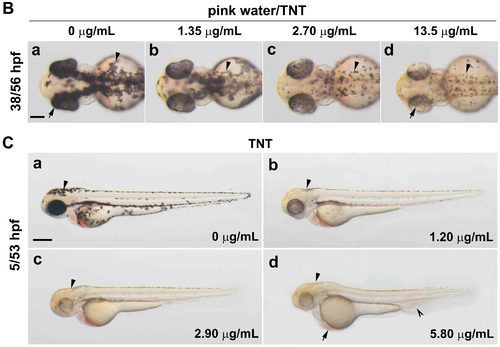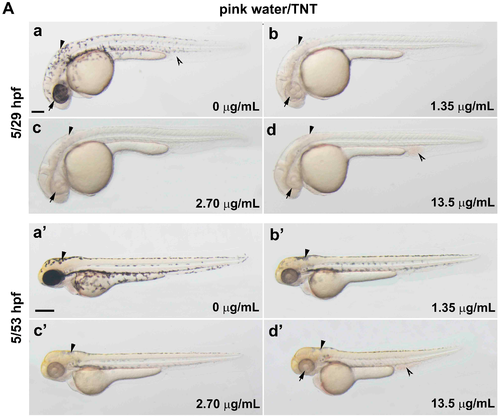Fig. 1
- ID
- ZDB-FIG-161222-8
- Publication
- Eum et al., 2016 - 3D Visualization of Developmental Toxicity of 2,4,6-Trinitrotoluene in Zebrafish Embryogenesis Using Light-Sheet Microscopy
- Other Figures
- All Figure Page
- Back to All Figure Page
|
Trinitrotoluene (TNT) in pink water causes developmental defects in zebrafish. (A) Bright-field lateral view of embryos treated with pink water. Embryos were exposed to pink water containing TNT at 0 µg/mL (a,a′), 1.35 µg/mL (b,b′), 2.70 µg/mL (c,c′), and 13.5 µg/mL (d,d′) from 5 till 29 hpf (a–d, scale bar 250 µm) or 53 hpf (a′–d′, scale bar 500 µm) and imaged using a stereoscope. Defects in pigmentation were evident at 29 hpf (a–d, arrow for eye color, arrowhead for body pigment, 3.2× magnification) and at 53 hpf (a′–d′, arrow for abnormal heart, arrowhead for body pigment, 2.5× magnification). Morphological changes in body shape and a defect in blood circulation (split arrowhead) were observed in embryos treated with pink water containing 13.5 µg/mL of TNT at 53 hpf (d′). 5/29 hpf, treatment starting at 5 hpf, observation at 29 hpf; 5/53 hpf, treatment starting at 5 hpf, observation at 53 hpf; (B) Dorsal views of embryos treated with pink water from 38–56 hpf. (a–d) Embryos show a dose-dependent pigmentation defect. Less pigment is visible in the eye (arrow) and trunk melanocytes (arrowhead). 8× magnification, scale bar 250 µm. 38/56 hpf, treatment starting at 38 hpf, observation at 56 hpf; (C) Embryos treated with TNT at 0 µg/mL (a), 1.20 µg/mL (b), 2.90 µg/mL (c), and 5.80 µg/mL (d) from 5 hpf had similar phenotypes to embryos treated with pink water, including pigmentation defect (arrowhead), abnormal heart (arrow), and defective blood circulation (split arrowhead). 5/53 hpf, treatment starting at 5 hpf, observation at 53 hpf, scale bar 500 µm. |


